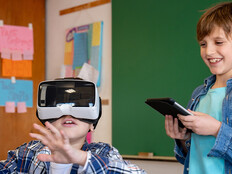What’s the Difference Between a Flipped Classroom and Flipped Learning?
"If only [insert subject here] were taught this way when I was in school, I might actually know how to do it."
I have said this countless times, and I hear it often from others. As executive director of the Flipped Learning Network (FLN), I have an "elevator speech" at the ready whenever people ask what flipped learning is.
Once I explain the concept — and they register how a flipped classroom could have changed their own learning experience — they nearly always respond with some variation of that refrain.
The Definition Of The Flipped Classroom
Usually, the quick explanation I offer describes a flipped classroom: In this scenario, teachers record their lectures, which students watch outside of class, and then dedicate class time to doing the homework. This approach facilitates learning by allowing students to ask questions of their teacher or collaborate with their peers as they're doing the work, rather than struggling with it at home and asking for help the next day.
Why do I characterize this explanation as a flipped classroom and not flipped learning? Because, contrary to popular belief, these terms are not synonymous. Yet nearly every article written on these topics mistakenly equates them.
To reverse this trend and provide clarity to both educators and the media, FLN's board of directors released a formal definition of both terms, along with pillars and indicators of how they're used, this past spring.
What are the most common misconceptions about a flipped classroom and flipped learning? Let's separate the facts from the fallacies.
Fact or Fallacy? A flipped classroom and flipped learning are similar terms used to describe the same approach.
Fallacy
Per FLN's "What Is Flipped Learning?" report, a flipped class "can, but does not necessarily, lead to flipped learning."
Many teachers may flip their classes by having students read text, watch supplemental videos or solve additional problems outside of class — as homework, during study hall or on the bus to a game.
Flipped learning, however, is a "pedagogical approach in which direct instruction moves from the group learning space to the individual learning space, and the resulting group space is transformed into a dynamic, interactive learning environment where the educator guides students as they apply concepts and engage creatively in the subject matter."
By moving from a flipped classroom to active engagement in flipped learning, teachers can implement new or multiple methodologies in their classrooms. It frees up class time, allowing for more individual and small-group instruction.
To engage in flipped learning, teachers must incorporate the "Four Pillars of F-L-I-P" into their practice (at right).
Flipped Learning Library
- Flip Your Classroom: Reach Every Student in Every Class Every Day, by Jonathan Bergmann and Aaron Sams (ISTE, 2012)
- Flipped Learning: Gateway to Student Engagement, by Jonathan Bergmann and Aaron Sams (ISTE, 2014)
- Flipping 2.0: Practical Strategies for Flipping Your Class, by Jason Bretzmann et al. (The Bretzmann Group, 2013)
- Implementation and Critical Assessment of the Flipped Classroom Experience, edited by Dr. Abigail G. Scheg (IGI-Global, forthcoming)
- Time for Learning: Top 10 Reasons Why Flipping the Classroom Can Change Education, by Kathleen P. Fulton (Corwin, 2014)
Fact or Fallacy? Only novice and tech-savvy teachers are using this method in their classrooms.
Fallacy
FLN research has found that, on average, eight out of 10 teachers who have embraced flipping have more than six years of experience. In fact, 42 percent of flippers have been teaching for 16 years or more, according to a joint survey by FLN and Sophia, a learning resource for teachers and students, in February 2014.
Clearly, the perception that only new-to-the-profession teachers, or those with a high degree of computer skills and comfort with technology, are flipping their classrooms is, in fact, a myth.
Fact or Fallacy? Only certain types of teachers are using this alternative instructional model.
Fallacy
Because Jonathan Bergmann and Aaron Sams (considered the pioneers of flipped learning) were high school science teachers, it's often assumed that flipped learning isn't used to teach other subjects.
But as more research and books on this topic have been published (see "Flipped Learning Library"), it has become clear that all grades and subject matter are being taught in a flipped manner.
In the FLN/Sophia survey, flipped teachers of high school math and science were still in the majority, at 33 percent and 38 percent, respectively. But there was significant growth in the number of English and language arts teachers who are flipping their classrooms — up from 12 percent in 2012 to 23 percent in 2014.
The 2012 survey didn't ask about other subjects, but the 2014 results showed that teachers of social studies (18 percent), technology and computer sciences (17 percent), and other subjects also are flipping instruction. One out of 10 teachers received his or her own professional development in a flipped fashion.
Fact or Fallacy? School leaders know nothing about this approach to teaching.
Fallacy
One out of four principals and superintendents surveyed by Project Tomorrow and the FLN in fall 2013 stated that flipped learning was already having a major impact on transforming teaching and learning, surpassing games and mobile apps (21 percent) and even online professional learning communities (19 percent). Nearly half of these administrators also indicated that they want their teachers to try the approach this year.
Fact or Fallacy? "I'm a flipped teacher and didn't know it."
Fact
Most teachers are embracing some of these concepts already. Take FLN's self-assessment (flippedlearning.org/definition), based on the four pillars, to measure your engagement level and determine your next steps.
The Four Pillars and 11 Indicators of F-L-I-P
Flexible Environment:
Learning Culture:
Intentional Content:
Professional Educator:
SOURCE: "What Is Flipped Learning?" (Flipped Learning Network, 2014)








